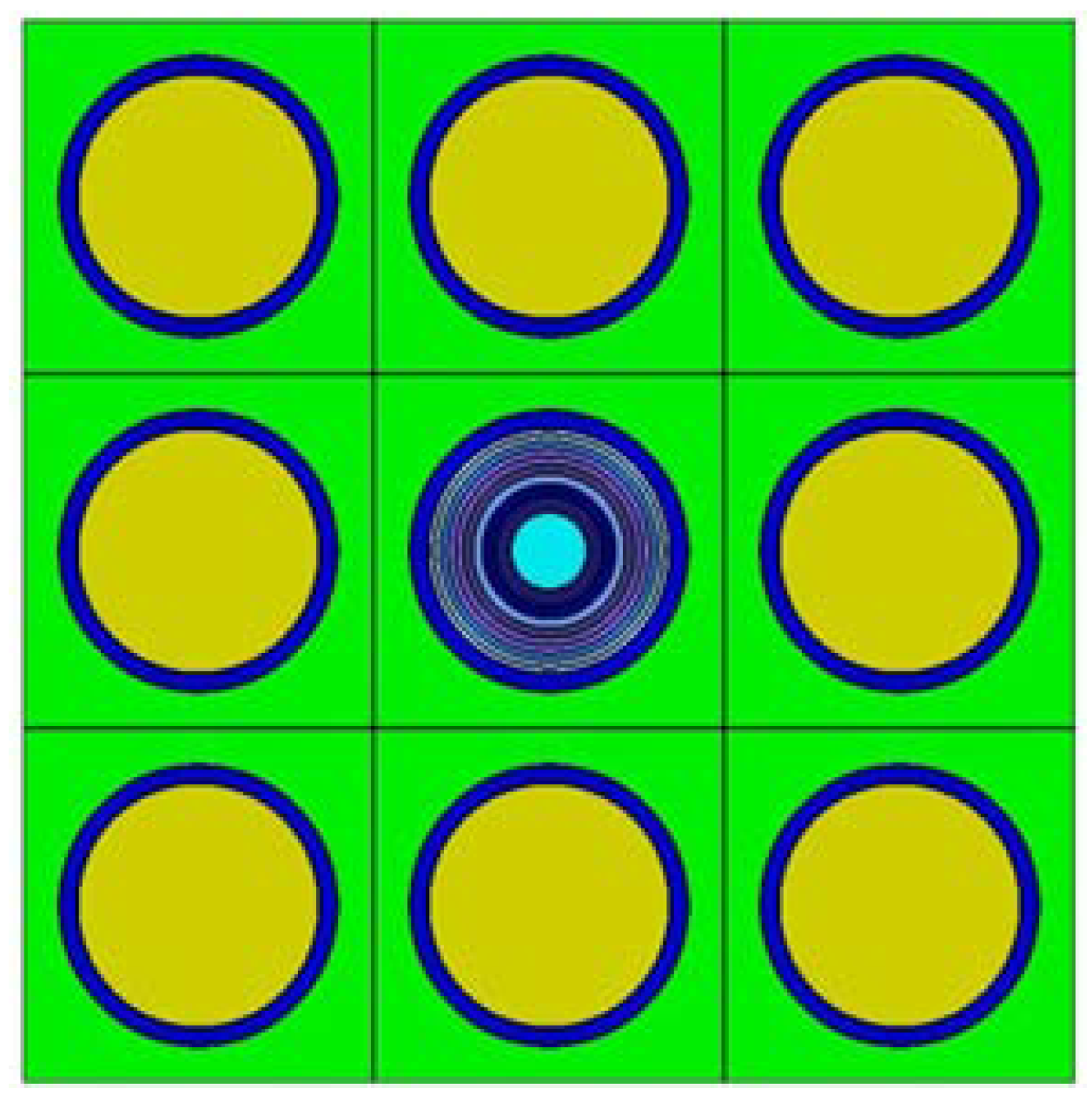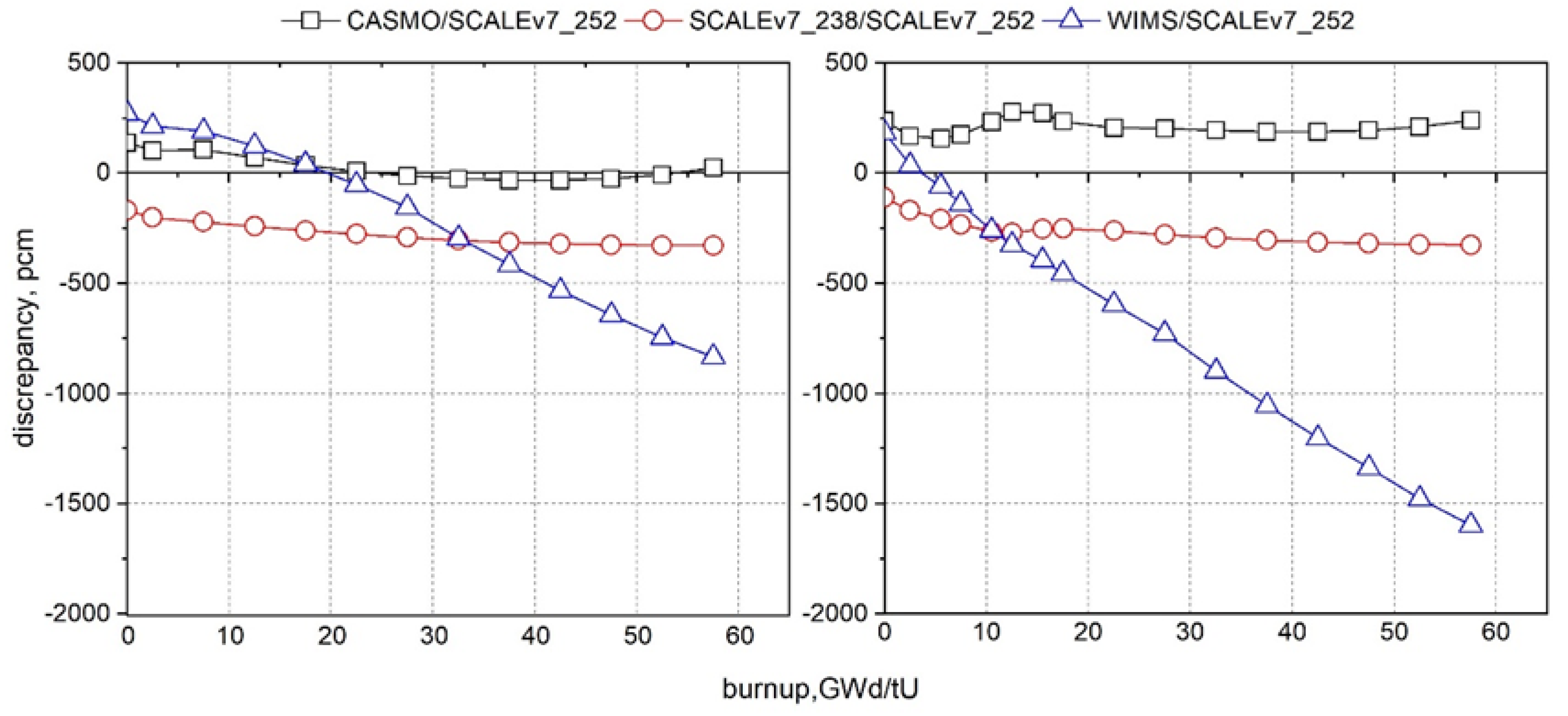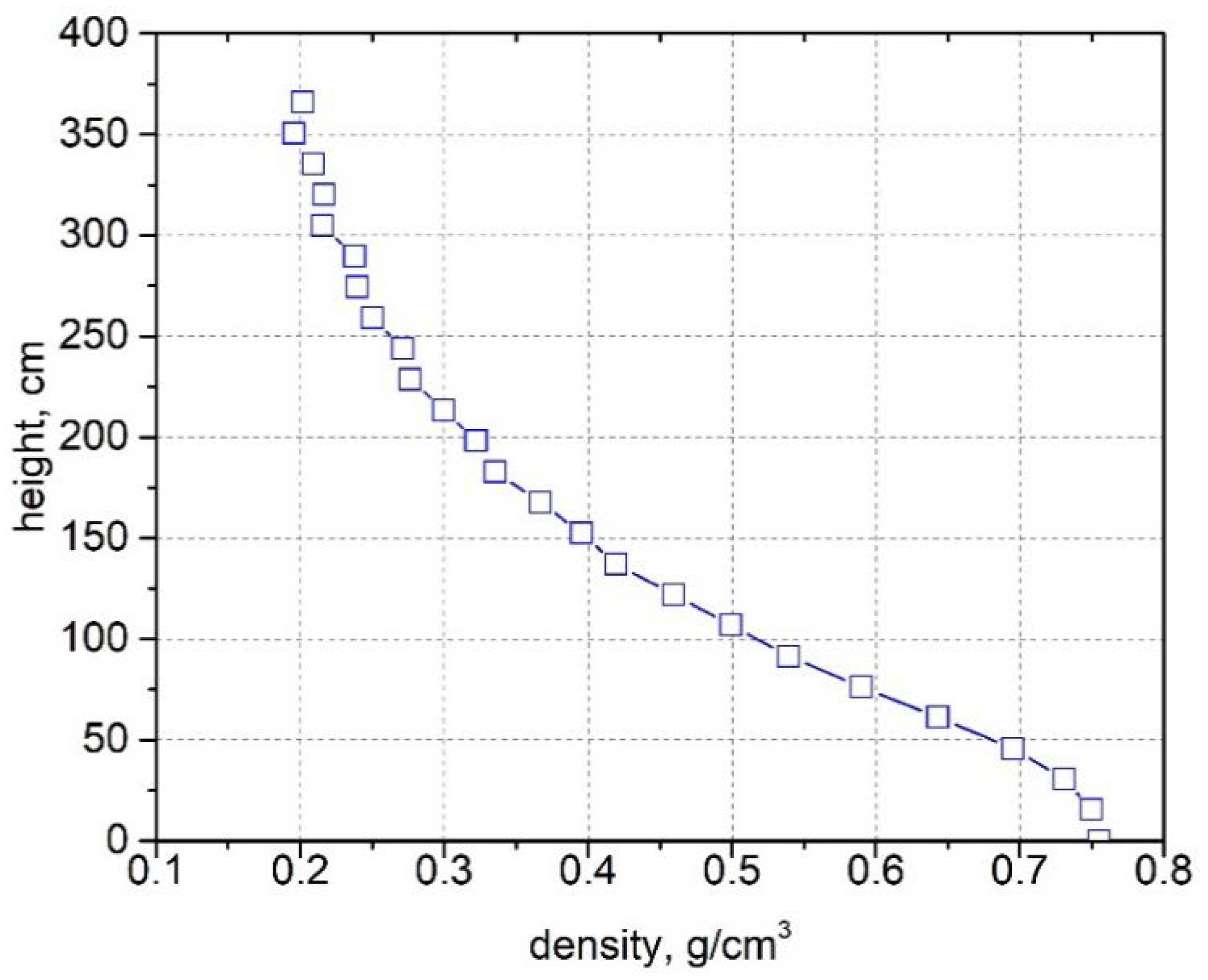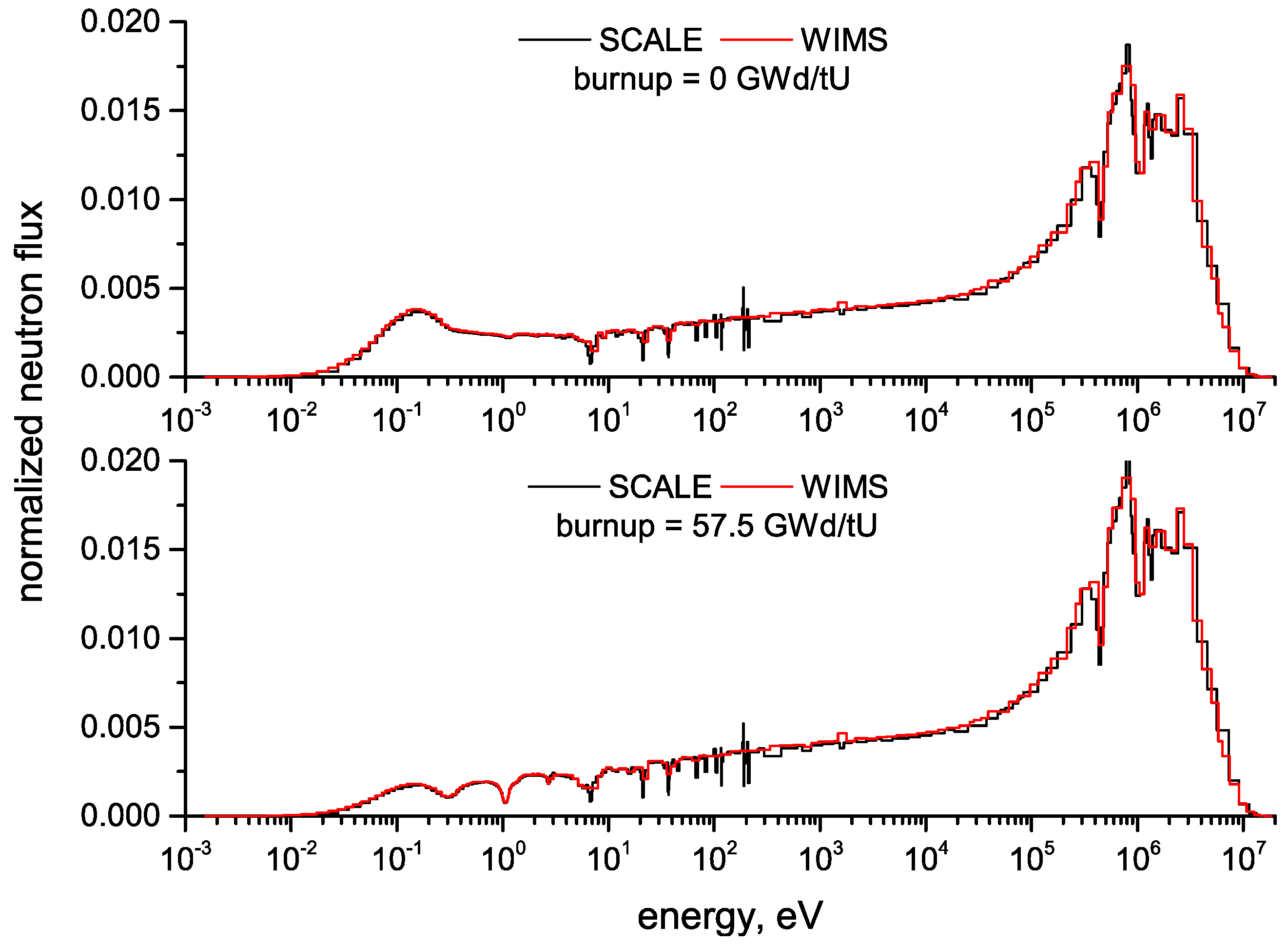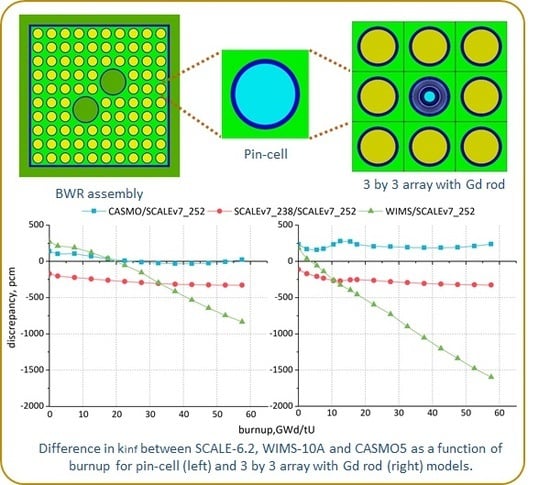4.1. Infinite Multiplication Factor
The infinite multiplication factor (k
inf) for both models was calculated from 0 to 57.5 GWd/tU range of burnup. CASMO5 and WIMS-10A results were compared against SCALE-6.2 with ENDF-VII.1 library. The discrepancy in k
inf between codes was defined as:
where
d is the discrepancy between code
i and SCALE-6.2 code in pcm;
kSCALEv7_252 is the k
inf calculated with SCALE-6.2 (v7_252);
ki is the k
inf calculated with code i;
i is one of the considered codes CASMO5, WIMS-10A or SCALE-6.2 (v7-238).
Figure 4 (left) shows the discrepancy in k
inf for BWR pin-cell model obtained using the SCALE-6.2 (v7-238), WIMS-10A and CASMO5 codes in relation to SCALE-6.2 (v7-252). It can be seen that results obtained using CASMO5 are in good agreement with SCALE-6.2 and v7_252 library, which gives an independent evaluation of the quality of the used reference code. The discrepancy between SCALE-6.2 (v7_252 library) and CASMO5 codes lies in the interval from −30 to +140 pcm. The infinite multiplication factor calculated by SCALE-6.2 with v7_238 library has a negative bias of around 300 pcm from SCALE-6.2 (v7_252 library), with discrepancy lying in the interval from −170 to −330 pcm. This bias is obviously caused by the usage of the somewhat older nuclear data libraries which have also slightly different energy structure, since the used solver is identical for these two cases. WIMS-10A and SCALE-6.2 (v7_252 library) comparison showed that the discrepancy between codes systematically increases with burnup and lies in the interval from −850 to 270 pcm, with a clear negative gradient over the whole burnup period.
Figure 4 (right) gives information about the discrepancy in k
inf between the considered codes for BWR 3 by 3 array with one gadolinia rod. In this much more challenging case, larger differences are observed. According to the results, there is an initial bias between SCALE-6.2 (v7_238), CASMO5 and SCALE-6.2 (v7_252) k
inf, which is equal to −110 and 230 pcm, respectively. The discrepancy between given codes over burnup lies in the intervals from −325 to −110 pcm (v7_238 library) and from 160 to 280 pcm (CASMO5). Thus, it can be considered that SCALE-6.2 and CASMO5 codes are also in good agreement with each other for the much more challenging systems with burnable absorbers. As for the BWR pin-cell model, a large discrepancy has been observed between WIMS-10A and SCALE-6.2 results. It varies from −1600 to 200 pcm for v7_252 library of SCALE-6.2 and increases with burnup and requires some further, in depth investigation. In this second case, the discrepancy for the WIMS-10A code once more grows with a strong negative gradient.
Figure 4 also shows that the discrepancy in k
inf between WIMS-10A and SCALE-6.2 significantly increases for the case with the burnable absorber which is more challenging for the solver. Consequently, these large discrepancies will propagate through the cross section set into the core simulator and can lead to shifts in the moderator density and burnup profiles in the full core analysis, which will affect the spread of the burnup distribution over the reactor core.
The university available, SCALE-6.2 and CASMO5 standard codes indicated a very good agreement in kinf, so an investigation between WIMS-10A and SCALE-6.2 was performed for the following sections.
Moderator density in the BWR reactor core varies significantly in terms of distance from the bottom of the core as it can be seen in
Figure 5. Thus, it is necessary to identify the impact of the moderator density on the level of discrepancy between codes. Burnup calculations for the BWR pin-cell model with several typical moderator densities such as 0.2, 0.3, 0.4 and 0.6 g/cm
3 were performed in the follow up analysis.
Figure 6 shows that the level of discrepancy between SCALE-6.2 and WIMS-10A increases slightly when the moderator density decreases. This means that for higher density configurations, closer to PWR operation conditions, WIMS-10A performs better than for lower density BWRs. However, all considered cases show the same tendency of a clear negative gradient which is much stronger than the effect of the water density changes. Thus, the water density variation does not have a significant effect on the systematic character of the discrepancy occurring over burnup. In this case, the typically considered challenge of BWRs, the wide spread of the water density and the resulting massive change in the criticality of the fuel assemblies are captured by both codes very well.
We consider SCALE-6.2 as a reference solution for the further steps of our analysis since it is the currently used university standard tool. It is obvious that there is a good agreement between the industry standard code CASMO-5 and SCALE-6.2. In addition, the code is very well validated for different types of light water reactors and for burnup calculations against Monte-Carlo solutions as given in the user manual [
8] and in an extensive report [
15] as well as against experimental data published in Nuclear Engineering and Design [
16].
4.2. Spectral Indexes Method
Spectral indexes (SI) are a method often used in the dosimetry and experimental analysis to get a deeper insight into the differences between model and experiment [
17] without taking too much weight into the absolute value of specific reaction rates. SI is described as a ratio between averaged over the same spectrum cross-sections of the isotope of interest and reference one [
18]. The method helps to reduce the effect of systematic biases, e.g., in the cross section set, and is often used for code quality and nuclear data library assessment. We will follow the idea of the SI method to identify the specific differences of the reaction rates produced by the different lattice codes to judge the consequence on the full core simulations. In [
17], spectral index was defined as the ratio of two microscopic fission cross-sections averaged over the same neutron distribution:
where
i and
r are the isotopes of interest and the reference one respectively;
and
are averaged microscopic cross-sections of the isotope
i and
r, respectively;
and
are microscopic cross-sections of the isotope
i and
r respectively;
φ is the neutron flux;
E is an energy.
Since the depletion calculations were performed under a constant power approach, the neutron flux estimated by each code is not necessarily identical. Hence, the averaged microscopic cross-sections cannot be used for the SI evaluation since they contain integrated neutron flux in the denominator which will not necessarily cancel out in (2). For the current study, we will define SI through the ratio of reaction rates between the reference isotope and the isotope of interest as:
where
and
are macroscopic cross-sections of the isotope
i and
r, respectively.
The analysis was performed for SCALE-6.2 and WIMS-10A codes. SI were estimated for the both models over total neutron spectrum for fission cross-sections of:
U-238 to U-235 or F28/F25;
Pu-239 to U-235 (F39/F25);
Pu-240 to Pu-239 (F40/F39);
Pu-241 to Pu-239 (F41/F39);
Pu-242 to Pu-239 (F42/F39).
The difference between spectral indexes was calculated as:
where
SIWIMS(
SISCALE) is the spectral index obtained with WIMS-10A and SCALE-6.2, respectively.
Figure 7 depicts the difference between the spectral indexes obtained using WIMS-10A and SCALE-6.2 codes and calculated for both considered models. It should be noted that for both models, U-238 and Pu-240 fission cross-sections are overestimated by WIMS-10A in comparison with SCALE-6.2, while for Pu-242 the cross-sections are underestimated. For the BWR pin-cell model the difference in the F40/F39 spectral index varies from 1.8% to 3.7%, for the F28/F25, from 0.4% to 1.5% and for the F42/F39, from −1.9% to 0.2%. For the BWR 3 by 3 array model, the difference in the F40/F39, F28/F25 and the F42/F39 spectral indexes gradually rises as burnup and varies from 2.3% to 3.3%, 0.5% to 2% and −1.5% to 0.4% respectively.
The difference in the F39/F25 spectral index rises with burnup in both models and varies roughly from −0.7% to 0.4%, while for the F41/F39 spectral index it has an opposite trend, and lies in the interval from approximately −0.4% to 0.4% for both models.
It should be noted that adding burnable poison to the system does not affect the main trends in spectral index difference as a function of burnup when compared to the UO2 fuel-containing system. Besides, the effect of the burnable poison is limited to the initial phase up to ~20 GWd/tU until the major part of the burnable poison is diminished. At this phase, Gd is competing in absorbing neutrons which affects Pu-239 accumulation and in addition the destruction of Pu-239 through the neutron absorption, leading to a reduced buildup of all higher plutonium isotopes. In the short term, it suppressed the deep in F39/F25 SI at the burnup 5 GWd/tU and, in the long term, decreased the difference between codes for this SI. Furthermore, in contrast with other SIs, F41/F39 sees almost no change for the model with burnable absorber in comparison with UO2 only.
The effect of spectral index discrepancy depends on the amount of isotopes appearing in the system. For example, inaccurate prediction of the Pu-240 fission cross section will lead to the incorrect estimation of its content, which will influence the capture reactions and thus the accumulation of isotopes along the breeding chain will not be preserved. It can significantly impact the final isotopic concentrations and the criticality of the spent fuel, especially in the case of modern high burnup fuel.
4.3. Isotopic Composition
The number densities of several main actinides for both models were calculated at the same set of burnup points using the SCALE-6.2 and WIMS-10A codes with Gd-155 for the BWR 3 by 3 array model. The difference between the number densities as a function of burnup for both models is shown in
Figure 8. It was estimated as a subtraction of SCALE-6.2 number densities from WIMS-10A ones at every burnup point of interest.
Already at first glance, it is clear that in both cases the two leading fissile isotopes U-235 and Pu-239 show different trends, with the Pu-239 content lower through the whole burnup period and the U-235 content lower after a short initial peak. This can partly explain the observed differences in the infinite multiplication factor. The trend to the increasing negative discrepancy correlates to a slightly lower amount of the main fissile isotopes. However, it would be unwise to claim here that the burnup model has deficiencies, since the formation and destruction of the leading Pu isotope 239 is a complex balance between power, isotopic composition, capture cross sections, neutron flux and neutron spectrum. All these parameters can be easily influenced by other parameters, e.g., discretization and/or self-shielding [
14].
The difference in number densities between WIMS-10A and SCALE-6.2 behaves similarly for U-235, Pu-240 and Pu-241 nuclides in both models. The behaviour changes for Pu-239 nuclide when instead of decreasing, the difference after 30 GWd/tU as in case of BWR pin-cell, it starts to gradually decrease slightly for the BWR 3 by 3 array model.
From initial time and up to 15 (10) GWd/tU in the case of the BWR pin-cell (3 by 3 array), U-235 is consumed more slowly in WIMS-10A than in SCALE-6.2; however, at around 30 GWd/tU the trend changes to the opposite effect and U-235 is being consumed faster.
As for the Pu-239 and Pu-241 isotopes, they accumulate constantly slower in WIMS-10A (underestimation) for both the pin-cell and 3 by 3 array models, while Pu-240 starts to build up faster from roughly 30 GWd/tU burnup.
Overall, the difference in U-235 number densities in WIMS-10A and SCALE-6.2 is almost twice as small for the model with the burnable absorber for burnups up to 20 GWd/tU. It can be related to the high absorption of neutrons by Gd at the beginning of the assembly life, which leads to a reduction in the thermal neutron flux and to the lower depletion of U-235 and, hence, a difference in the number densities.
As was mentioned in [
2], 70% of the reactivity reduction in the storage cask system with BWR spent fuel comes from major actinides. Hence, it is important to have a reliable, robust estimate of their number densities for the high target burnups. The given results show that for fuel assemblies with typically discharged burnups (40–50 GWd/tU), the difference in number densities between SCALE-6.2 and WIMS-10A for major actinides becomes significant in both cases. For example, number densities for Pu-239 differ by around 1.5% at the EoL in the case of BWR pin-cells. This would account to a 180 pcm difference in k
inf, while the change in number densities of the other observed isotopes would account for the additional 150 pcm.

